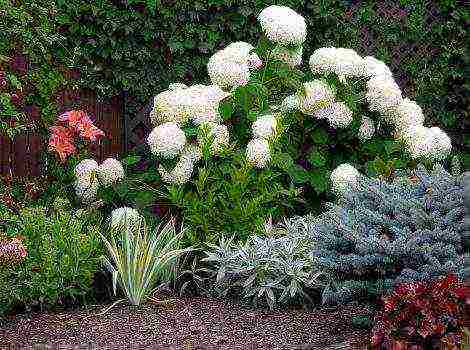Content
The genus Proleska (Scilla) has more than 90 species of bulbous herbaceous plants growing mainly in cool regions of Europe, Asia, North Africa. These miniature perennials usually bloom in early spring, although there are several autumn-flowering species, for example, the autumn scilla (Scilla autumnalis). Plants attract with their blue, blue, white and pink flowers.
Scylla is an ephemeral plant, the rhizomes and bulbs of which accumulate and contain a supply of nutrients, and spend most of their life underground. Therefore, the growing season for this fragile primrose is very short. After a flowering period in early or mid-summer, the leaves turn yellow and die off, and a dormant period begins. The perennial will rest for several months before the start of the next growing cycle.
Care Tips
The redhead in cultivation is unpretentious and easily reproduces by self-seeding, caring for it does not pose any difficulties. It thrives in a variety of light conditions - from full sun to partial shade and even shade, but it is better to choose a place with sufficient sunlight for planting, especially for species that bloom in early spring, when solar activity is not so high.
Landing of Scylla
In early autumn, when the plant is at rest, the bulbs are planted in a well-drained, loose, organic-rich soil (peat, rotted manure) to a depth of 10-15 cm and 5 cm apart. For planting, choose an area without stagnant water after rain, as the plant will not develop in swampy soil. The bulbs are small, rounded with small dots at the top. These points should be at the top when landing. Bulbs take root already in the fall, and in some species and varieties, leaves and flowers develop before winter.
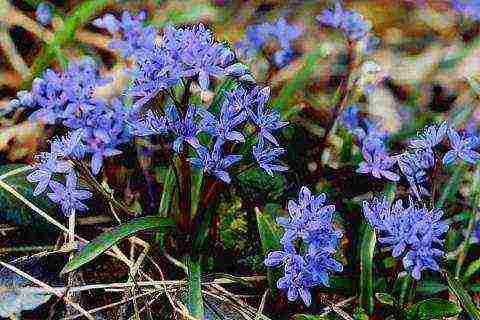
Watering
During the active growing season, careful watering as needed after the top layer of the substrate has dried. Try to keep water out of the flowers. Mulching the soil surface with bark, leaves, small pebbles helps to maintain moisture and contributes to the comfortable growth of Scylla. Do not use coniferous bark and walnut leaves for mulching, as when decomposed, they increase the acidity of the soil, and this negatively affects the perennial.
Top dressing
Top dressing with a complex mineral fertilizer in late autumn or early spring at the very beginning of the growing season promotes abundant flowering.
Reproduction
Proleska reproduces vegetatively - by dividing baby bulbs or by self-seeding. In the first case, the bulbs are divided from a 3-year-old plant after the leaves have wilted. They are planted immediately to a permanent place or stored until autumn planting in a container with peat in a cool room. A perennial can grow in one place for about 5 years.
In garden design, it is suitable for decorating a rock garden, for forcing in pots. With this charming plant, you can create a forest landscape in your garden by planting Sprouts in groups among the grass, next to trees, shrubs and conifers.
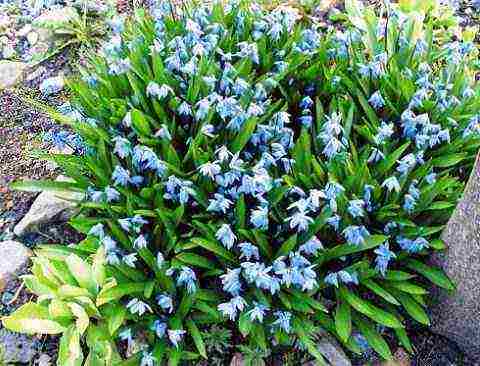
Types of Proleski
Hyacinth
It blooms in spring and looks like a hyacinth. The peduncle reaches 80 cm. It requires protection from the wind.
Spanish
One of the best early summer species. Completely undemanding to maintain and adapts to a wide range of light and soil conditions. Ideal for shady garden areas. It goes well with violets, lilies of the valley.
Italian
The pale blue flowers with blue stamens have a pleasant aroma. Blooms in May. Looks good with meadow grasses, muscari, tulips, daffodils.
Siberian Prleska
Abundantly blooming species. Refers to early primroses. Grows well in sun or light shade. Does not tolerate drought and high temperatures. After flowering, it is resistant to trampling.
When you hear the name of these flowers, the myths of Ancient Greece with their "Scylla and Charybdis" involuntarily come to mind. But how terrible Scylla is in ancient Greek mythology, so beautiful are the Scylla in early spring in the garden. In our area, another name for the scilla is more popular - scrub. Marina Gerasimenko (one of the gardeners at GreenColor) pushed me to study these beautiful flowers with her spring garden, where, as usual, woods grew. And the name "scilla" these flowers got thanks to the plant "sea onion", which at first was mistakenly attributed to the forest forest, but then ranked among the hyacinths. Scylla belongs to the lily family.
Proleski - one of the first plants of spring, many people mistakenly take
white scilla flowers
for snowdrops.
Flowers
scyllas can be not only white, but also pale blue, blue, pink or purple.
Growing a scilla
Due to its unpretentiousness, Scylla is a welcome guest in alpine hills, rockeries and all kinds of flower beds. Many "flower gourmets" use scilla for forcing on New Year's Eve, planting the bulb in pots with drainage, leaf peat, fertile soil, and river coarse sand.
As I said, Scylla is unpretentious and has no peculiarities when planting, it loves neutral or slightly acidic soils, saturated with leaf peat and rich in humus. He does not like swampy places, he likes the soil to be loose and moist. It is better to plant this plant in the shade, but the scrub will also grow in lighted places.
Reproduction of scilla
1. Seeds. It is necessary to collect the boxes with Scylla seeds when the boxes turn yellow and begin to crack (this is around the end of June), after collecting them, they must immediately be sown into the ground, since they have a very low germination capacity. After several years, the spines will bloom. And it is advisable to leave them in one place for about 5 years, so that the plant multiplies flower stalks and forms more "children".
2. Bulbs. During the growing season, an adult bulb gives on average about 2 children. When the foliage of the scilla dies off (June), feel free to plant the children in the ground at a distance of about 5 cm from each other. To a depth of about 3 cm.
Self seeding is possible in Scylla. Therefore, if you find it in the wrong places after the snow melts, do not be surprised.
Scylla care
The Scylla does not require special care, but if in early spring before flowering the woodland is “fed” with nitrogen and potassium fertilizers, they will bloom and multiply better.
Scylla needs to be covered for the winter, provided it is planted in an open area. If you need to transplant or divide the plant, then try to do this no earlier than after 3 years. For the first time, the planted Scylla is watered and loosened the soil surface, it can be mulched so that moisture remains and there are no weeds.
Types of scilla
There are about 90 types of Scyllas, "scattered" in the meadows of different European countries and our Slavic expanses.
When the garden is just awakening from sleep, the two-leaved scilla (scrub) begins to bloom, it pleases the eye with blue, white, pink flowers. It blooms in the second half of April and lasts about 2 weeks. This is a low plant (up to 15 cm) with 3 peduncles, on which, like stars, about 15 flowers are scattered. In the south of our huge country, you can find a scilla of this species with delicate white flowers - in the Crimea, the Mediterranean. This scilla species has a very strong and pleasant scent that attracts butterflies and bees.
Later, the Siberian Scylla begins to please the eye, it blooms with beautiful white or blue flowers. She has several beautiful subspecies (Siberian Armenian Scylla, Caucasian Siberian Scylla, Siberian Siberian Scylla Siberian subspecies).
The name was given by mistake, the birthplace of the Siberian Scylla is the south of Russia, the Caucasus, the Crimea, and it does not grow in Siberia. In the spring, it forms a “carpet” of beautiful, densely growing blue flowers. In this type of scilla, leaves appear along with flowers.
When the seed pods ripen, the leaves dry out. Scylla of this species rests all summer, and in autumn it begins to gain strength in bulbs and form the rudiments of leaves and flowers. The flowers of the Siberian Scylla are like an alarm clock, they open their beautiful cups by 10 am and close by 5 pm. This species is very sensitive to the sun, if it is raining or cloudy, the flowers will not open. The leaves of the Siberian Scylla are like "solar batteries": in cloudy, cool weather, they practically lie on the ground in a horizontal position, absorbing ultraviolet light as much as possible, and in hot, sunny weather they rise almost vertically to the stem and flowers. Propagated by seeds. During vegetative propagation, the species is not renewed and the plant does not rejuvenate.
Blooms later than the rest scilla tubergen (Mishchenko), she pleases the eye with white and blue flowers. On the perianth leaves, like a vein, a blue stripe is visible. Leaves are juicy green, long, elongated. One bulb gives birth to about 4 small arrows (about 15 cm), on which, like stars, about 7 flowers grow.
Scylla Tubergen
Scylla Rosen will bloom with her at the same time (at the end of April). The bright green leaves seem to wrap the stem around. If you walk through the meadows of the Caucasus, she will definitely meet you there, smiling with 1-2 beautiful large blue flowers with a lilac shade. Anthers of cyclamen-like flowers are bright blue, filaments are flat, snow-white.
Do not think that there are only spring flowers, there are species that cannot part with gardeners even in autumn, for example, the autumn Scylla - the time of its flowering falls on the beginning of August. She is a frequent visitor to Crimea, but she also meets our gardeners. The flowers are blue with purple edges, but more often lilac-blue.
Plant these delicate flowers in your garden and they will delight you with their transparent beauty from early spring to late summer.
Discuss this article on the forum
- How to grow a Chionodox
- Begonia Bauer - reproduction and care
- Telekia - care and cultivation
- How to properly water cyclamen
- Stapelia home care
When you hear the name of these flowers, the myths of Ancient Greece with their Scylla and Charybdis involuntarily come to mind. But how terrible Scylla is in ancient Greek mythology, so beautiful is she in the garden in early spring. In our area, another name is more popular -
scrub
.
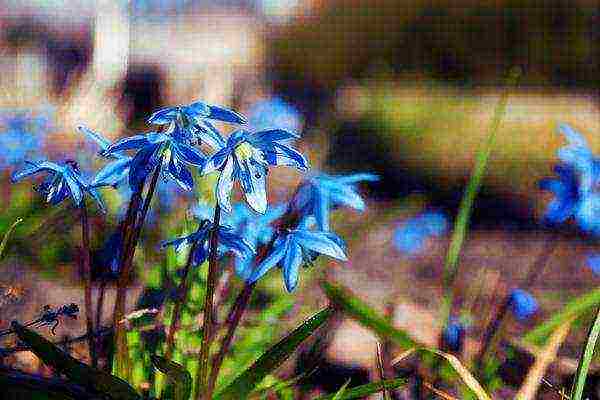
Scylla, or the scrub Pushed me to study these beautiful flowers Marina Gerasimenko with her spring garden, where, as usual, the breeches grew. These flowers got their name "scilla" thanks to the sea onion plant (its ancient Greek name Skilla is spelled as Scilla in Latin transliteration). Scylla belongs to the Asparagus family, although earlier it was referred to as Liliaceae or Hyacinths.
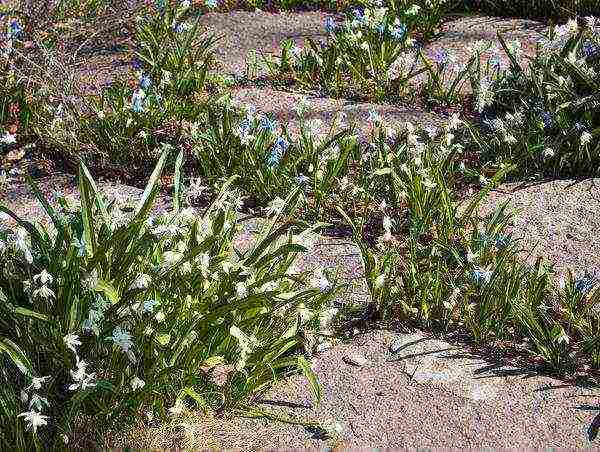
Slabs between the slabs of the garden path
Scylla flowers are one of the first plants of spring, many mistakenly mistake the white flowers of the scilla for
snowdrops
... They can also be pale blue, blue, pink or purple, depending on the species and variety.
Growing a scilla
Scylla landing
Due to its unpretentiousness, Scylla is a welcome guest in alpine slides, rockeries and all kinds of flower beds.
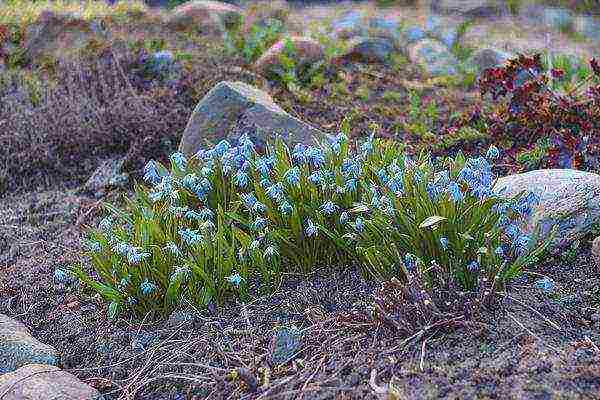
Scylla is a welcome guest in alpine hills, rockeries and all kinds of flower beds. Many "flower gourmets" use Scylla for forcing on New Year's Eve, planting bulbs in pots with drainage, leaf peat, fertile soil and coarse river sand.
As I said, Scylla is not picky, loves neutral or slightly acidic soils, saturated with leaf peat and rich in humus.

Scylla transplant Does not like swampy places, the soil should be loose and moist. It is better to plant this plant in the shade, but the scrub will also grow in lighted places.
Reproduction of scilla
1. Seeds
You need to collect the seeds of Scylla then,
when the boxes turn yellow and start to crack (this is about the end of June). After collecting them, they must immediately be sown into the ground, since their germination capacity is very low.
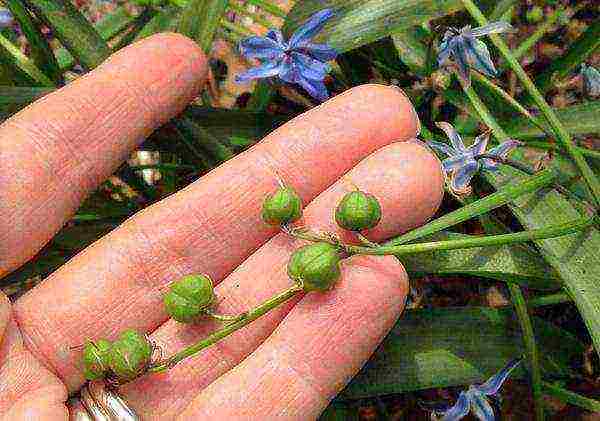
Scylla seed pods (immature).
After several years, the spines will bloom. And it is advisable to leave them in one place for about 5 years, so that the plant multiplies flower stalks and forms more "children".
2. Bulbs During the growing season, an adult bulb gives on average about 2 children. When the foliage of Scylla dies off (June), feel free to plant the children in the ground on about 3 cm deep and about 5 cm apart.
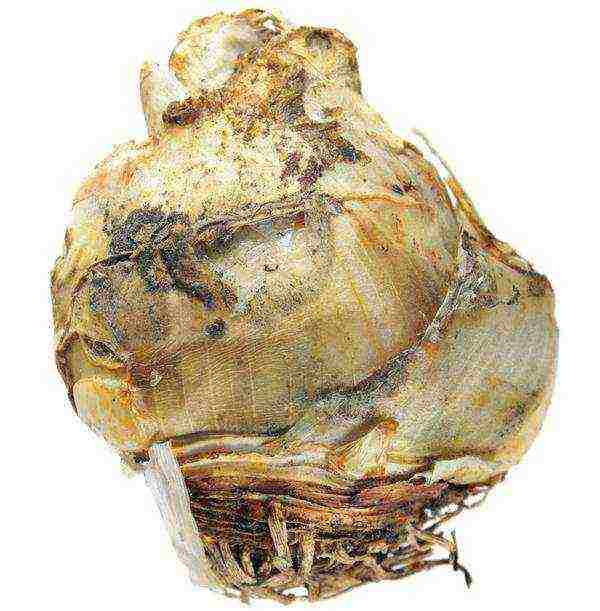
Scilla peruviana Bulb Therefore, if you find it in the wrong places after the snow melts, do not be surprised.
Scylla care
Scylla does not require special care, but if you feed it in early spring before flowering
nitrogen
and
potash fertilizers
, it will bloom and multiply better.
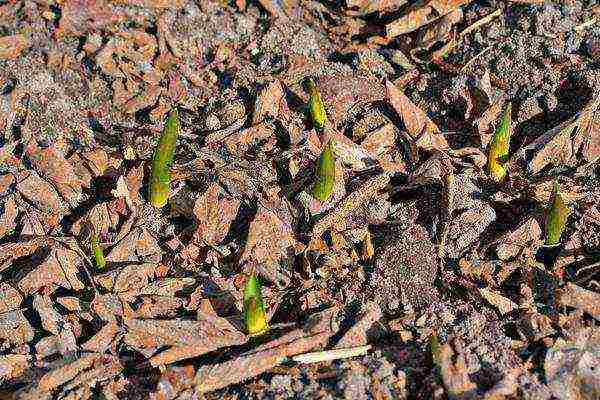
Scyllas in early spring In the first year, Scyllus needs shelter for the winter, especially if you planted it in an open place. You will find recommendations for sheltering bulbs in the article Mistakes when preparing a garden for winter. Shelter of plants.
If you need to transplant or divide the plant, then try to do it not earlier than in 3 years... For the first time, the planted Scylla is watered and loosened the soil surface, it can be mulched so that moisture remains and there are no weeds.
Types of scilla
There are about 90 types of scyllas, "scattered" in the meadows of different European countries, including in the vastness of our country.
Double-leaved scaffold
When the garden is just awakening from sleep, two-leaved scilla (Scilla bifolia) begins to bloom. She pleases the eye with blue, white, pink flowers. It blooms in the second half of April and lasts about 2 weeks. This is a low plant (up to 15 cm) with 3 peduncles, on which, like stars, about 15 flowers are scattered. In the south, you can find a double-leaved forest with delicate white flowers - in the Crimea, the Mediterranean. This scilla species has a very strong and pleasant scent that attracts butterflies and bees.

Double-leaved scilla (Scilla bifolia). Photo:
Siberian Proleska
Later, the Siberian scrub (Scilla siberica) begins to please the eye, it blooms with beautiful blue or white flowers.
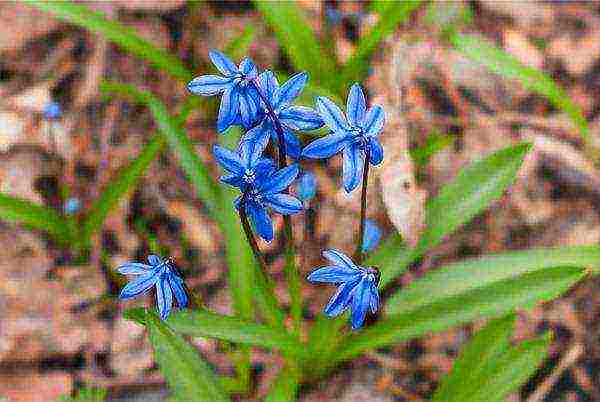
Siberian Scilla (Scilla siberica) It has several beautiful subspecies: Scilla sibirica subsp. caucasica, S. sibirica subsp. armena (Siberian scrub, Caucasian subspecies, Siberian Siberian subsp. Armenian), etc.
The name of the species was given by mistake, the birthplace of the Siberian Scylla is the south of Russia, the Caucasus, the Crimea, and it does not grow in Siberia. In the spring, it forms a “carpet” of beautiful, densely growing blue flowers. Leaves of this type of scilla appear along with flowers.
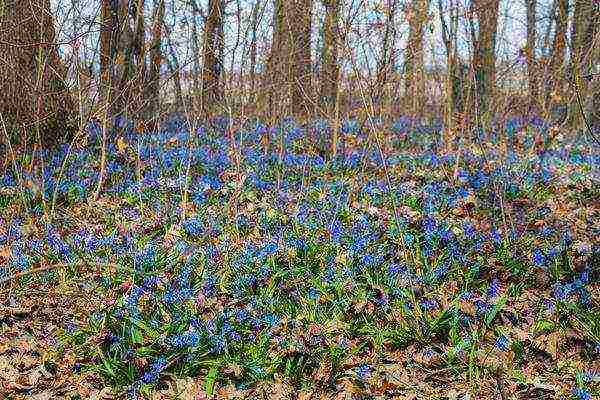
Forest carpet in spring forest
When the seed pods ripen, the leaves dry out. Scylla of this species rests all summer, and in autumn it begins to gain strength in bulbs and form the rudiments of leaves and flowers. The flowers of the Siberian forest, like an alarm clock, open their beautiful cups by 10 am and close by 5 pm.
This species is very sensitive to the sun: if it is raining or cloudy, the flowers will not open. The leaves of the Siberian Scylla are like "solar batteries": in cloudy, cool weather, they practically lie on the ground in a horizontal position, absorbing ultraviolet light as much as possible, and in hot, sunny weather they rise almost vertically to the stem and flowers. Propagated by seeds. During vegetative propagation, the species is not renewed and the plant does not rejuvenate.
Proleska Tubergen, or Proleska Mishchenko
Later, the Tubergen's spade (Scilla tubergcniana, Scilla mischtschenkoana) blooms later than the others.
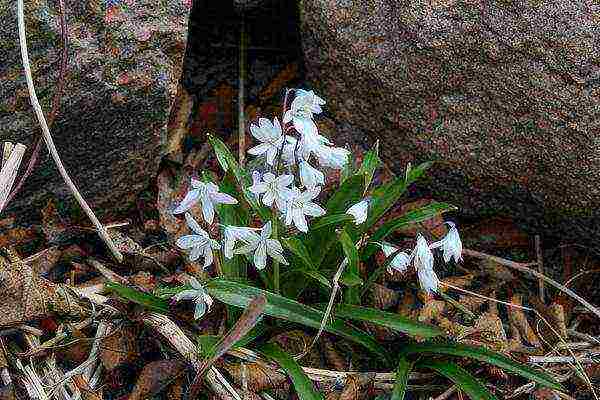
Scilla tubergeniana, Scilla mischtschenkoana). Photo: Uleli, sv.wikipedia.org She pleases the eye with blue and white flowers. On the perianth leaves, like a vein, a blue stripe is visible. Leaves are juicy green, long, elongated.One bulb gives birth to about 4 small arrows (about 15cm), on which, like stars, about 7 flowers grow.
Proleska Rosen
At the same time, at the end of April, it blooms
Rosen's scrub (Scilla rosenii) ... The bright green leaves seem to wrap the stem around. If you walk through the meadows of the Caucasus, she will definitely meet you there, "smiling" with 1-2 beautiful blue flowers with a lilac hue. Anthers of cyclamen-like flowers are bright blue, filaments are flat, snow-white.
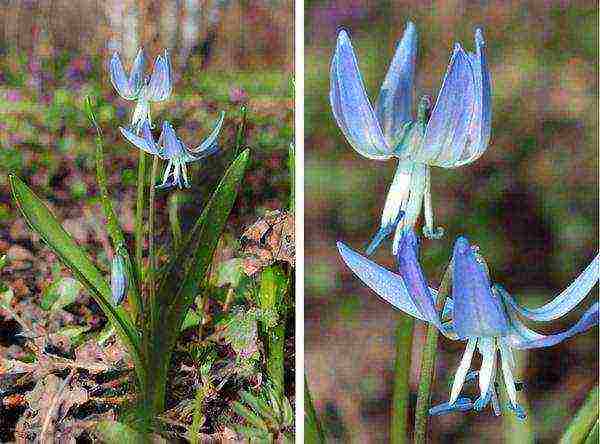
Rosen's Scilla (Scilla rosenii). Photo:
Autumn screech
Do not think that there are only spring flowers, there are species that cannot part with gardeners even in autumn, for exampleautumn forest (Scilla autumnalis). The time of its flowering falls on the beginning of August. She is a frequent visitor to Crimea, but she also meets our gardeners. The flowers are blue with purple edges, but more often lilac-blue.
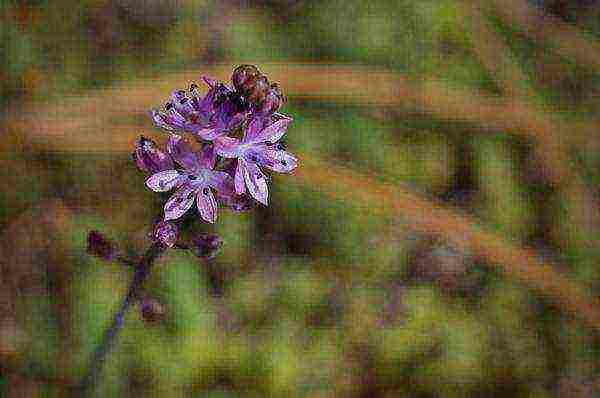
Autumn scilla (Scilla autumnalis).
You can find out about other types of woodlands, including rare and exotic ones, from the article of our expert Lyudmila Uleiskaya
The flowers of my childhood are woodlands
.
Plant these delicate flowers in your garden and they will delight you with their transparent beauty from early spring to late summer.
 Proleska (Latin Scilla) belongs to the genus of bulbous perennials of the Asparagus family, although it used to be part of the Hyacinth or Liliaceae family. Another name for the scilla. Sometimes a spit is confused with a forested or snowdrop. The genus includes about 90 species of plants living in mountain meadows and plains in Asia, Africa and Europe. The scilla plant gets its name from the Greek name for the sea onion - skilla, which used to belong to this genus. The flowers are distinguished by their high decorativeness and frost resistance, resistance to diseases and the ability to adapt to any conditions.
Proleska (Latin Scilla) belongs to the genus of bulbous perennials of the Asparagus family, although it used to be part of the Hyacinth or Liliaceae family. Another name for the scilla. Sometimes a spit is confused with a forested or snowdrop. The genus includes about 90 species of plants living in mountain meadows and plains in Asia, Africa and Europe. The scilla plant gets its name from the Greek name for the sea onion - skilla, which used to belong to this genus. The flowers are distinguished by their high decorativeness and frost resistance, resistance to diseases and the ability to adapt to any conditions.
), Content
- 1. Listen to the article (coming soon)
- 2. Scylla flower (scrub) - description
- 3. Planting a scilla in open ground
- 3.1. Planting a scilla in open ground
- 3.2. How to plant a spit into the ground
- 4. Caring for Scylla in the garden
- 4.1. How to grow a branch
- 4.2. Transplanting scilla (scilla) in the garden
- 4.3. Reproduction of scilla
- 4.4. Scylla pests and diseases
- 5. Scylla after flowering
- 6. Types and varieties of scilla (woodland)
Scylla flower (scrub) - description
Proleska is a perennial bulbous plant. Scylla bulbs are round or ovoid, with dark gray, purple or brown outer scales. Leaves are linear, basal, appearing earlier or simultaneously with the apical racemose inflorescences on leafless peduncles. A characteristic feature of the Scylla leaves is that on cloudy and cold days they are pressed to the ground, and in warm and sunny weather they take a position close to vertical. The inflorescences of the woodland consist of single flowers. Blue spines are common, but there are varieties and varieties with purple, white, purple, and pink flowers. The fruit of the scilla is a capsule with black seeds of an irregular ovoid shape. Along with flowers such as crocus (or saffron), brandu, adonis (or adonis), white flower, spring (or erantus), lumbago (or dream grass), hyacinth, goose onions, muscari, daffodil, snowdrop, pushkinia, primrose , chionodoxa, dwarf iris, hazel grouse and buttercup, scilla flower is a primrose. Redwoods usually bloom in early spring, although there are species that bloom in autumn.
The topic of our article is planting woodland and caring for it in the open field.
// Planting a scilla in the open ground // When to plant a spit into the ground.
Planting and caring for a scylla outdoors is not difficult at all. The sapling plant is planted most often on alpine slides, curbs, in mixborders or rockeries. The trunks of fruit trees, decorated with flowering branches in early spring, also look very elegant. Scylla can be planted even during flowering, however, it is better to plant spring woods after the leaves die off, from the second half of June, and autumn flowering Scylla - a month before the development of peduncles. Like all flowers, the blueberry loves good lighting, although it can grow in partial shade, and spring-flowering species are more photophilous than those that bloom in autumn.
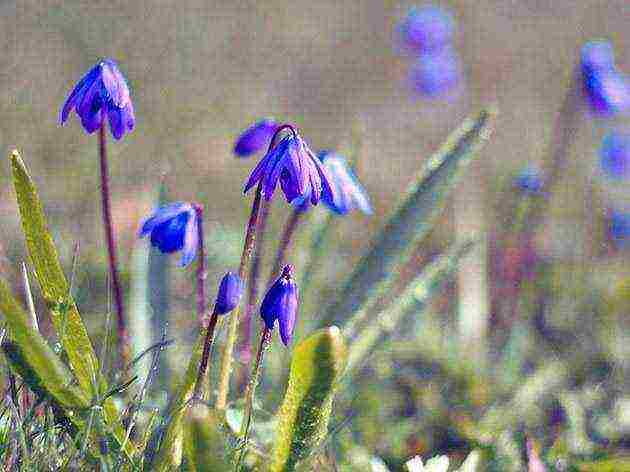 How to plant a spit into the ground.
How to plant a spit into the ground.
Planting and caring for the cabbage tree begins with the preparation of the site.The best soil for Scylla is a soil rich in organic matter, containing leaf humus and mineral components. To grow well in your garden, you need to add some forest soil with half-decayed foliage and tree bark to your garden soil. The soil for the woodland should be moderately moist, but it does not like swampy soils, like acidic ones. The optimum pH of the soil for the woodland is 6.5-7.0 pH.
Shedding bulbs are placed in holes located at a distance of 5-10 cm from each other, to a depth of 6 to 8 cm, depending on the caliber of the planting material.
// Caring for a scylla in the garden How to grow a spit.
Perhaps the scilla is one of the most unpretentious spring plants. Caring for the proleskaya consists in watering with the obligatory subsequent loosening of the soil to a depth of 2-2.5 cm and removing weeds. It is better to water the scillas in the morning, trying to pour water so that it does not fall on the flowers - from this, the spines lose their decorative effect. To make your work easier, mulch the planting with deciduous humus, after which you will have to water and loosen the soil less often.
For feeding in early spring with a complex fertilizer, for example, Nitrofoskoy, the bluehead will respond with abundant flowering, but the species of Scylla blooming in autumn are best fed in the fall. It is advisable to add trace elements calcium, iron, copper and magnesium to a solution of a complex mineral fertilizer.
You need to know that many types of Scylla reproduce by self-seeding, and if you do not want the spines to suddenly bloom in the places reserved for other plants, remove the testes from them in a timely manner.
// 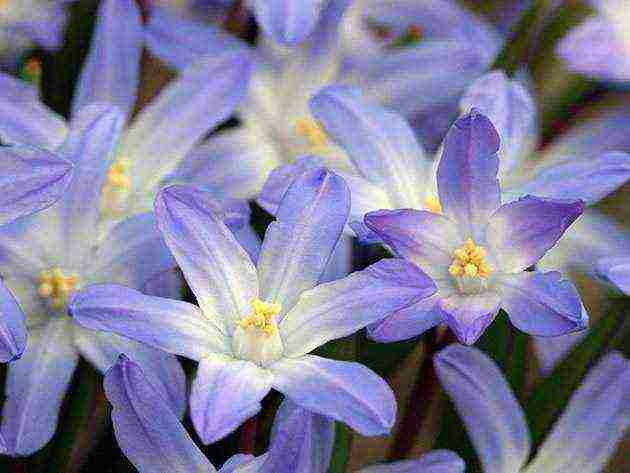 Transplanting scilla (scilla) in the garden.
Transplanting scilla (scilla) in the garden.
Scylla care involves transplanting the plant once every three years. In order for the spines not to lose their decorative effect, they need to be dug up and, separated from the baby's bulbs, they should be planted as quickly as possible in order to avoid rotting of the bulbs. The best time for this procedure is late September or early October.
Reproduction of the scilla.
Scylla is propagated by bulbs and seeds. We have just described the method of propagation by bulbs. As for seed reproduction, the first task is to get seed: as soon as the seed pods turn yellow and begin to crack, and this happens around the end of June, you need to cut the pods, extract seeds from them and sow them. Seed germination is low, and you will only see the flowering of scilla from seeds in 3-4 years. For the first time, you will not have to plant the spines grown from seeds until after five years - you need to give the plant time to multiply flower stalks and grow more children.
Pests and diseases of scilla (woodland).
Like other small-bulb crops, Scyllae are affected by diseases such as bulb rot, gray rot and achelenchoides. Of the pests for tree forests, the most dangerous are mouse rodents and the root meadow mite.
Gray mold attacks the leaves of the plant and the tops of the bulbs, causing them to become covered with gray mold fluff and rot. Following this, dense specks form on the bulbs. As a result of the development of the disease, woodlands turn yellow and die. Diseased plants should be destroyed immediately. On bulbs affected by gray rot during storage, diseased areas are cut out, and the wounds are treated with wood ash.
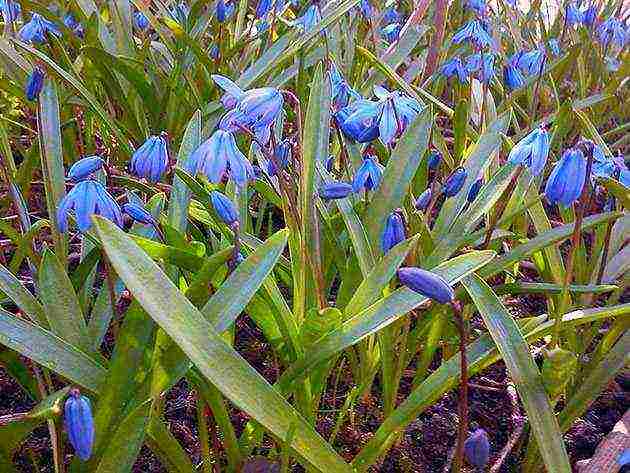
Achelenchoides affects both the terrestrial part of the plants and the bulbs, causing their scales to turn brown, which makes the bulbs rot - ring rot can be seen in their cross section. The surface of the diseased bulb is covered with necrotic spots. Plants infected with achelenchoides lose their decorative effect and begin to lag behind in development. Bulbs of damaged plants must be dug up and destroyed, and healthy bulbs are kept for half an hour in a thermos with hot water (43 ºC) for prevention.
Bulb rot can be caused by fungal infections such as sclerotinia, fusarium and septoria. The first sign of the disease is yellowed leaves of the plant, then the infection penetrates the bulbs, from which dirty red spots are formed on them.When stored, diseased bulbs become hard and die. These diseases progress in conditions of high air humidity.
Mouse-like rodents, namely voles, house and field mice, feed on the bulbs of the scilla, and in the spring they eat up its shoots. In order not to allow the mice to destroy the planting of the forest, a protective groove is made around it, into which the poisoned baits are laid and lightly sprinkled with earth so as not to accidentally poison the birds.
The root meadow mite and its larvae sharpen the bottom of the bulb, penetrate into its middle and feed on the juice of its inner scales, which leads to rotting and drying of the bulb. To kill the tick, they resort to treating plants with insectoacaricides - Aktellik, Agravertin, Akarin and similar preparations. As a preventive measure, Scylla bulbs are etched with the same drugs before planting in the ground.
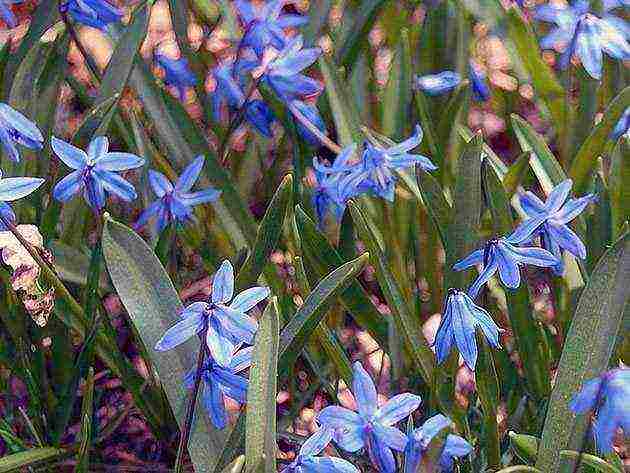 Scylla after flowering //
Scylla after flowering //
After flowering, the flowering shoot of the Scylla is immediately cut off, the leaves are removed only when they themselves completely die off. As for the preparation of the plant for wintering, almost all types of scilla are frost-resistant, therefore they normally hibernate without shelter. But it is better to cover spruce branches or dry leaves growing in open areas for the winter.
As you can see, planting a scilla and caring for it is not at all laborious, especially since it can be grown by self-seeding.
Types and varieties of scilla (proleski)
Since there are a lot of species of woodland, including in culture, we offer you an acquaintance only with the most famous of them, as well as with the most popular Scylla varieties in floriculture.
Scilla hispanica,
she is the campanulate scilla, she is also the Spanish endymion (Endymion hispanicus), originally from the forests and meadows of Portugal, Spain and the south of France. This is perhaps the most beautiful type of woodland: a plant of short stature (20-30 cm), with a single peduncle and bell-shaped blue, pink and white flowers up to 2 cm in diameter, collected in 5-10 pieces in an erect racemose inflorescence. Scylla bellflower blooms from the end of May for a little less than two weeks. The bulbs of this species left in the ground need to be covered for the winter. The best varieties of Scylla bell-shaped:
- - Rose Queen is a scilla with pink flowers with a lilac hue and a barely noticeable aroma on peduncles about 20 cm high,
- - Sky Blue - large blue flowers with a blue stripe, located on powerful peduncles in a spiral,
- - La Grandes is a plant with white flowers, of which there are about fifteen in each inflorescence,
- - Rosabella - lilac-pink fragrant flowers, collected in a dense inflorescence on peduncles up to 30 cm high. By the evening, the aroma of flowers intensifies.
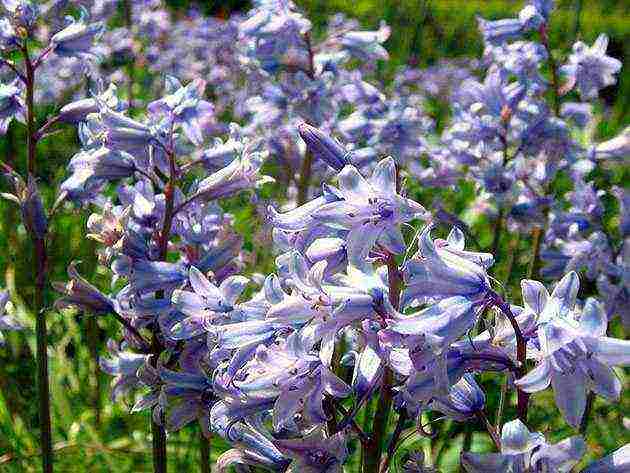
In addition to those described, the varieties of the bell-bottomed Excelsior, Blue Queen, Blue Giant, Blue Pearl, Dainty Maid, Queen of Pinks, Mont Everest, Miosotis and others have proven themselves well.
Double-leaved scilla (Scilla bifolia),
or double-leaved scilla, widespread in nature in the Mediterranean, Crimea, European Russia and the Ciscaucasia. This is the most abundant and undersized species of the scilla. A plant about 15 cm high bears from one to three peduncles, each of which forms an inflorescence of white or pink flowers with a strong and pleasant smell, up to 15 pieces. The two-leaved scilla, as the name implies, has only two broad-linear leaves up to 20 cm long. Flowering in plants of this species begins in the second half of April and lasts about two weeks. In culture, the species has been since 1568. There is a garden form bifolia var. Purpurea with purple flowers.
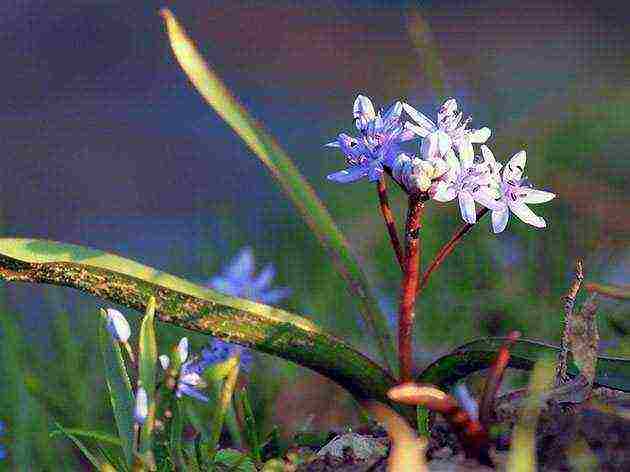 Autumn Scilla (Scilla autumnalis),
Autumn Scilla (Scilla autumnalis),
or Scylla autumnal, grows in the wild in the Mediterranean, North Africa and Asia Minor. This plant gives up to 5 flower arrows 15-20 cm high, on which small flowers of reddish-purple or pale lilac color open, collected in loose clusters of 6-20 pieces. The beginning of flowering is the end of July or the beginning of August. The leaves of the plant are linear, grooved, narrow, up to 25 cm long. This species has been cultivated since 1597.
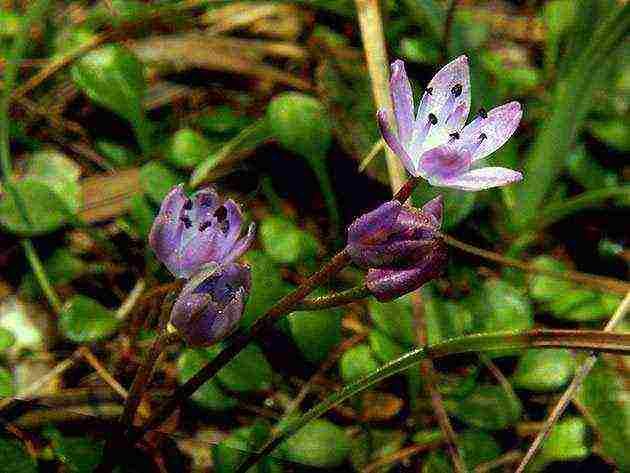 Scilla peruviana,
Scilla peruviana,
or Scylla Peruvian, comes from the Western Mediterranean. This plant develops 2-3 flower arrows up to 35 cm high with small bright blue flowers less than 1 cm in diameter, collected in a dense conical inflorescence. One inflorescence can contain up to 80 flowers. The leaves of the Peruvian scilla are linear, up to 30 in length and up to 1.5 cm in width.There can be from 5 to 8 of them on one plant.
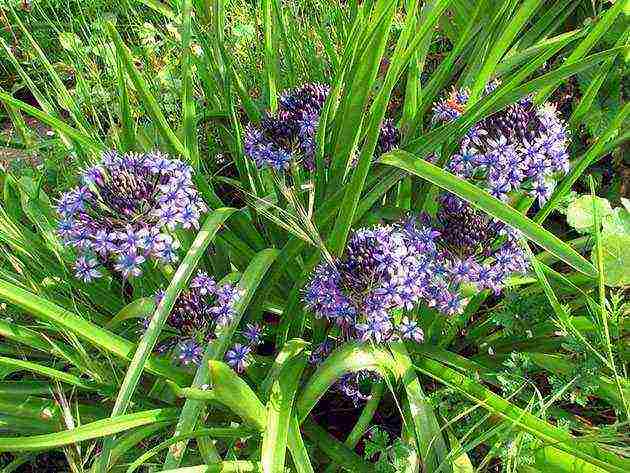 Siberian beetle (Scilla sibirica),
Siberian beetle (Scilla sibirica),
or Siberian Scylla, got its name by mistake, since it does not grow in Siberia. Its habitats are the European part of Russia, the Caucasus, Crimea, as well as Southern and Central Europe. The leaves of this species appear simultaneously with the blue flowers containing nectar. The peculiarity of flowers of this species is that they open at 10 o'clock and close at 16-17 o'clock, and in cloudy weather they may not open at all. The Siberian Scylla has three subspecies:
- - Caucasian (Scilla sibirica subsp.caucasica), found in the Eastern Transcaucasia. In plants of this subspecies, arrows are from 20 to 40 cm high, the flowers are dark blue with a purple tint, blooming for two to three weeks from mid-spring,
- - Armenian (Scilla sibirica subsp. Armena), which grows in southern Transcaucasia and northeastern Turkey. In the Armenian subspecies, the leaves are sickle-curved, the arrows are only 10-15 cm long, the bright blue flowers open in mid-spring and bloom for two to three weeks,
- - Siberian (Scilla sibirica subsp. Sibirica) grows in the mountains, bushes and forests of the Caucasus, Crimea, Asia Minor and Asia Minor, as well as the European part of Russia. This is the most famous subspecies of the woodland in the culture. Its plants have 3-4 broad-linear leaves up to 1.5 cm wide, the number of peduncles up to 30 cm high on one plant can be from 1 to 4, azure flowers bloom in mid-spring and bloom for about three weeks. The subspecies has been cultivated since the beginning of the 17th century. The white-flowered form of this subspecies has been cultivated since 1798, it blooms a week and a half later, a sap of a different color, but blooms for almost four weeks. In addition to plants with white flowers, there are varieties with pink and blue colors. The most famous varieties of the Siberian subspecies of Siberian redwood:
- - Spring Beauty - currently the best variety of the species with powerful purple-green peduncles and five to six flowers of a dark purple shade with a diameter of about 3 cm. The variety is very popular in Western European culture. Its peculiarity is also in the fact that it does not set seeds, but it easily reproduces by children,
- - Alba is a variety with very beautiful snow-white flowers, creating a spectacular contrast to the Spring Beauty flowers.
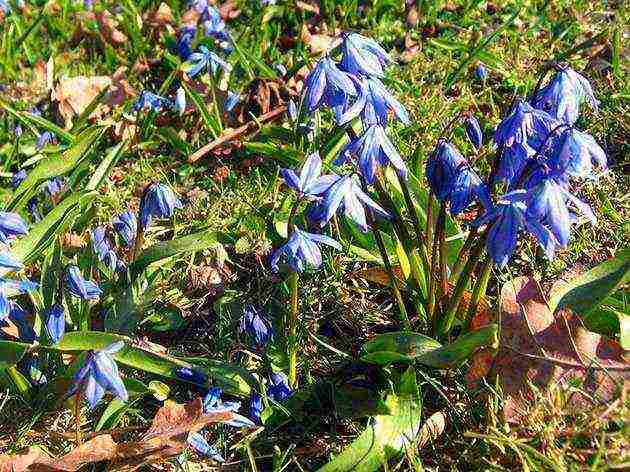
In addition to the species described, grape, Pushkiniform, Rosen, Tubergen (or Mishchenko), purple, single-flowered, sea (sea onion), Litardier, Chinese (proleskidnaya), Italian, Vinogradova, Bukhara (or Vvedensky) are in demand in the culture.
,
Snowberry - planting and care in the open field, reproduction and haircut
Poultry house - planting and care in the open field, species and varieties,) 5 1 1 1 1 1 Rating 5.00 (3 vote (s))
